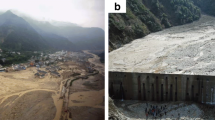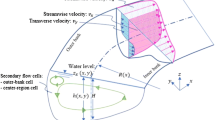Abstract
This paper presents a 3D mathematical model for suspended load transport in turbulent flows. Based on Dou’s stochastic theory of turbulent flow, numerical schemes of Reynolds stresses for anisotropic turbulent flows were obtained. A refined wall function was employed to treat solid wall boundaries. The equations for 2D suspended load motion and sorting of bed material have been expanded into 3D cases. Numerical results are validated by the measured data of the Gezhouba Project, and proved to be in good agreement with the experimental. The present method has been employed to simulate sediment erosion and deposition in the dam area of Three Gorges Project, and for the operation of the project, siltation process and deposition pattern in the near-dam area of the reservoir, size distribution of the deposits and bed material, and flow fields and sediment concentration fields at different time and elevations are predicted. The predicted results are close to the experimental observations in physical model studies. Thus, a new method is established for 3D simulation of sediment motion in dam areas of multi-purpose water projects.
Similar content being viewed by others
References
McAnally, W. H., Leter, J. W., Tomas, W. A., Two- and three-d modeling systems for sedimentation, in Proc. of the 3rd Int. Symp. on River Sedimentation, The University of Mississippi, U.S.A., 1986.
Chen, R. F., Modeling of estuary hydrodynamics. — A mixture of art and science, in Proceedings of 3rd International Symp. on River sedimentation, The University of Mississippi, 1986.
Wang, S. Y., Adeff, S. E., Three-dimensional modeling of river sedimentation processes, in Proc. of the 3rd Int. Symp. on river sedimentation, The Univ. of Mississippi, 1986, 1594–1601.
Demuren, A. O., Rodi, W., Calculation of flow and pollutant diffusion in meandering channels, J. Fluid Mech., 1986, 17(2): 63–92.
Demuren, A. O., Calculation of sediment transport in meandering channels, Tech. Session A, in Proc., 23rd IAHR Congr., Inernational Association for Hydraulic Research, Delft, the Netherlands, 1989.
Demuren, A. O., Development of a mathematical model for sediment transport in meandering rivers, Rep. No. 693, Inst. For Hydromechanics, University of Karlsruhe, Karlsruhe, Germany, 1991.
Odgaard, A. J., Bergs, M. A., Flow processes in a curved alluvial channel, Water Resour. Res., 1988, 24 (1): 45–56.
Rijn, L. C. Van, Mathematical modeling of morphological processes in the case of suspended load transport, Delft Hydra. Communication No. 382, Delft, the Netherlands, 1987.
Shimizu, Y., Yamaguchi, H., Itakura, T., Three-dimensional computation of flow and bed deformation, J. Hydra. Engrg., ASCE, 1990, 116 (9).
Fernette, R., Dhatt, G., Tanguy, J. M., A three-dimensional finite element sediment transport model, in Proceedings of 5th International Symposium on River Sedimentation, University of Karlsruhe, 1992, 365–374.
Prinos, P., Compound open flow with suspended loads, Advance in Hydro-Science and Engineering, Part B, The University of Mississippi, 1993, 1: 1206–1214.
Wang, S. Y., Jia, Y., Computational modeling and hydroscience research, Advances in Hydro-Science and Engineering, in Proceedings of 2nd International Conference on Hydro-Science and Engineering, Beijing: Tsinghua University Press, 1995, 2147–2157.
Lin, B. L., Falconer, R. A., Numerical modeling of three-dimensional suspended load for estuarine and coastal waters, J. Hydra. Res., 1996, 34(4): 435–456.
Wu, W. M., Rodi, W., Wenka, T., 3D numerical model for suspended load transport in open channels, J. Hydr. Engrg., ASCE, 2000, 126(1): 4–15.
Olsen, N. R. B., Skoglund, M., Three-dimensional suspended load for estuarine and coastal water, J. Hydra. Res., 1994, 32(6): 833–844.
Olsen, N. R. B., Kjelesvig, H. M., Three-dimensional numerical flow modeling for maximum local scour depth, J. Hydra. Res., 1998, 36(4): 579–597.
Fang Hong-wei, Wang Guang-qian, Three-dimensional mathematical model of suspended-sediment transport, J. Hydra. Engrg., ASCE, 2000, 126(8): 578–592.
Dou Guoren, The stochastic theory and the general law of all flow regions for turbulent open channel flows, in proceeding of First International Symposium on River Sedimentation (in Chinese), Beijing: Guanghua Press, 1980, 151–161.
Dou Guoren, Turbulence Flow Dynamics (in Chinese), Vol. A, Beijing: People’s Education Press, 1981.
Dou Guoren, General law of laminar flows and turbulent flows in open channels and pipes, Science in China (in Chinese), Ser. A, 1982, (5): 472–480.
Dou Guoren, Application of the stochastic theory of turbulent flows in the boundary layer, J. of Nanjing Hydraulic Research Institute (in Chinese), 1983, (4): 1–12.
Dou Guoren, Turbulence Flow Dynamics (in Chinese), Vol. B, Beijing: Higher Education Press, 1987.
Lu Yongjun, Han Longxi, Yang Xianghua, 3D turbulent flow sediment mathematical model and its application in sediment erosion and deposition in the dam area of Three Gorges Project, Research Report of Nanjing Hydraulic Research Institute(in Chinese), Sept. 2002.
Holly, F. M., Jr, Rahuel, J. L., Numerical physical framework for mobil-bed modelling, J. of Hydraulic Research, 1990, 28(4): 401–416.
Ye Jian, Dou Guoren, A new turbulent flow model —K-∈-S model, J. of Nanjing Hydraulic Research Institute (in Chinese), 1990, 3: 1–10.
Launder, B. E., Spalding, D. B., The numerical computation of turbulent flows, Comp, Methods Appl. Mech. Eng. 1974, 3: 269–289.
Rodi, W., Turbulence Models and Their Application in Hydraulics —A State of the Art View, Karlsruhe: University of Karlsruhe, 1984.
Ye Jian. Researches of K-∈-S model of turbulent flows and its application. Ph D. Dissertation (in Chinese)., Nanjing: Nanjing Hydraulic Research Institute, 1989.
Qian Ning, Wan Zhaohui, Mechanics of Sediment Transport (in Chinese), Beijing: Science Press, 1983.
Rijn, L. C., Van Sediment transport, Part III: Bed fonns and alluvial roughness, J. Hydra. Engrg., ASCE, 1984, 110(12): 1733–1754.
Zhang Ruijin, Xie Jianheng, Wang Mingfu et al., River sediment dynamics (in Chinese), Beijing; Water Resources and Electric Power Press, 1989.
Han Qiwei, He Mingmin, Mathematical model (1D) of reservoir deposition and riverbed evolution, J. Sediment Research (in Chinese), 1987, (3): 14–29.
Thompson, J. F., Warsi, Z. U. A., Mastin, C. W., Numerical Grid Generation, Amsterdam: North-Holland, 1985.
Willemse, J. B. T. M., Solving Shallow Water Equations with an Orthogonal Coordinate Transformation, Delft Hydraulics Communication, 1986, 356: 1–28.
Patankar, S. V., Numerical Heat Transfer and Fluid Flow, Washington D.C.: Hemisphere Publishing Co. 1980.
Zhou Jianjun, Research report of calculation of 2D sediment mathematical model of the dam area of Three Gorges Project, Collection of Sediment Research Reports for the Dam Area of Three Gorges Project on Yangtze River (in Chinese), Vol. 1, Beijing: Patent Literature Press, 1997, 575–624.
Yangtze River Scientific Research Institute, Research report of package scheme for the approach channel in the upstream of Three Gorges Project —Experimental researches on sediment models, Researches on Sediment Problems of Three Gorges Project on Yangtze River (1996–2000) (in Chinese), Vol. 3, Beijing: Intellectual Property Press, 2002, 1455–1520.
Tsinghua University, Research report of package scheme for the approach channel in the upstream of Three Gorges Project — Experimental researches on sediment model for the dam area, Researches on Sediment Problems of Three Gorges Project on Yangtze River (1996–2000) (in Chinese), Vol. 3, Beijing: Intellectual Property Press, 2002, 614–1665.
Nanjing Hydraulic Research Institute, Research report of package scheme for, the approach channel in the upstream of Three Gorges Project — Experimental researches on sediment deposition and navigation flow conditions in the dam area 3 Researches on Sediment Problems of Three Gorges Project on Yangtze River (1996–2000) (in Chinese), Vol. 3, Beijing: Intellectual Property Press, 2002, 1521–1613.
Author information
Authors and Affiliations
Corresponding author
Rights and permissions
About this article
Cite this article
Lu, Y., Dou, G., Han, L. et al. 3D mathematical model for suspended load transport by turbulent flows and its applications. Sci. China Ser. E-Technol. Sci. 47, 237–256 (2004). https://doi.org/10.1360/03ye0268
Received:
Issue Date:
DOI: https://doi.org/10.1360/03ye0268




